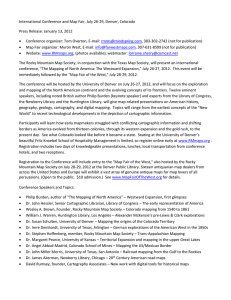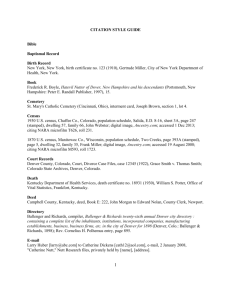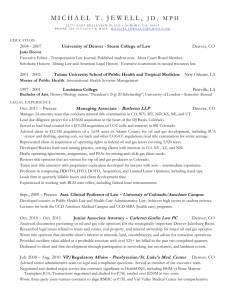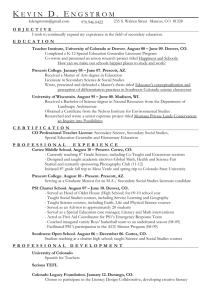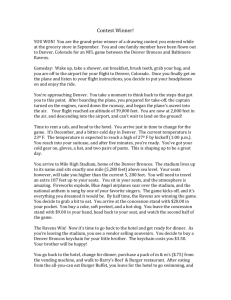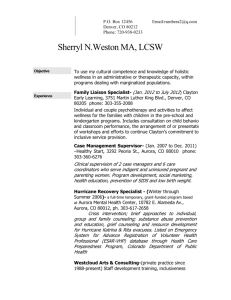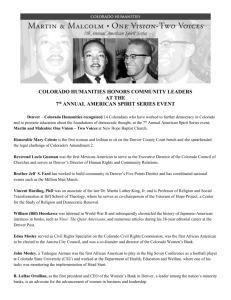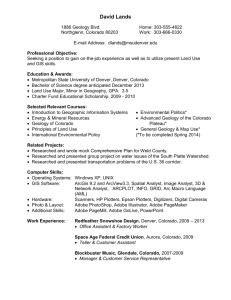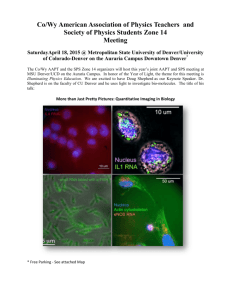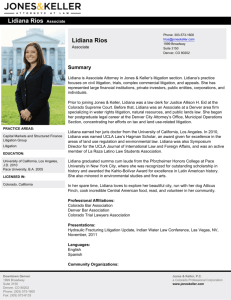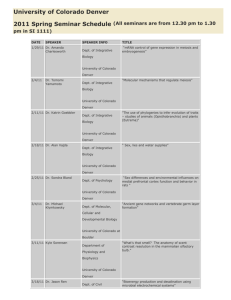COLTT Presentation
advertisement
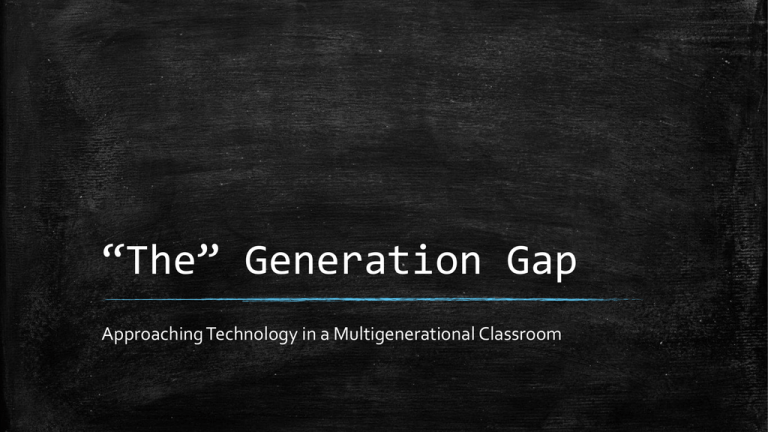
“The” Generation Gap Approaching Technology in a Multigenerational Classroom Schedule . . . ▪ Current Classrooms ▪ Problems across the different generations ▪ Discussion ▪ Some possible approaches ▪ Questions The future of the classroom . . . ▪ How many of you have “technology” or “multimodal” assignment on your syllabus? ▪ How many use your university or college’s online portal or platform? (D2L, Blackboard, etc.) ▪ How many of you teach hybrid or online classes? ▪ Most institutions are is encouraging, and often requiring, the use of technology in the classroom, from requiring grade posting on the school’s online platform to fully integrated smart classrooms. – Technology in the classroom Classes (for teachers) – Almost all writing classes require some type of assignment that involves technology or the creation of a multimodal composition – Research is almost exclusively done online – Instructors utilize technology such as presentation software or smart classrooms for lectures – Digital content and texts Terminology . . . ▪ Designers – creators of multifaceted compositions (images, text, multimodal) ▪ Netizens/Digital Natives – generation raised on technology ▪ ICT – information communications and technology ▪ Technoliteracy – just like it sounds http://www.rvceupdates.com/blog/wpcontent/uploads/2014/05/you-may-take-notes.jpg Average age of some Colorado institutions . . . Median Student Age @ Colorado Schools 34 32 30 28 26 24 22 20 CU Denver MSU Denver RRCC ACC Undergraduate CMC UNC CCD The reaction . . . ▪ “For students with limited of no ICT background, completing an assignment using a word processing, spreadsheet or presentation software program may eclipse their subject-specific knowledge and skills” (Tannis 3). ▪ Commonly heard from these nontechnological students: – – – – “I haven’t been in school for 10/20/30 years . . .” “I just don’t understand these programs.” “Computers just don’t work for me.” “This stuff is beyond me.” ▪ “It’s an emotional drain. It isn’t that I haven’t got the ideas, but the technology was beating me” (Tannis 2). What this means for the older generations . . . ▪ “Most of us over the age of 30 view computers as tools by which we engage in discussion, do research, write notes and lectures and the like” (Moody and Bobic 176). ▪ Out of their element: – Obstacles before the classroom (registration, Assessment testing, online portals, etc.) – Returning to school after years/Low Self-esteem – Different generation with different expectations and priorities – Socialization moved online – Disconnect with other students and faculty – Access – Inventing not only the university, but technological identity as well The Net Generation isn’t exempt . . . “Perhaps the most important point of the sociofact of technology is that students do not understand the process of adding to knowledge: theirs is a world of information streaming past them at the speed of light . . . [o]ne does not create new knowledge; one manipulates information. In this digital stream, everyone can be an expert on any topic with only a few clicks on relevant Web pages” (Moody and Bobic 177-8). http://www.wall321.com/thumbnails/detail/20120625/facebook%20internet%20meme%20google%20youtube %20twitter%20myspace%20wikipedia%20deviantart%201600x900%20wallpaper_www.wall321.com_88.jpg What it means for them . . . ▪ Paradoxically, the net generation’s knowledge and immersion in technology often makes them ill-prepared for the classroom as well. ▪ Common problems: – Disconnect between instructor’s (often a non-netizen) expectations and student’s beliefs – Misguided research skills – Confusion about critical thinking – Tendency to regurgitate information – Misunderstanding of argument – Revision – Informality – Dual identity – Disproportionate knowledge of different technologies ▪ “[F]itting in academically requires students to write differently online than they do offline. Two discourses are needed to meet the literacy demands of contemporary academe” (Relles and Tierney 484) http://www.graduationsource.com/bl og/wpcontent/uploads/2014/01/textingwriting-skills-cartoon.jpg Faculty and Classroom obstacles . . . ▪ Time: – How much does the instructor want to dedicate to teaching technology instead of planned curriculum (in or out of the classroom)? – How much time do you have to learn it? (pressure on the instructor for “expert” knowledge) ▪ Other Students: – Disproportionate learning/knowledge – Different levels of expertise ▪ Support from school: – Students are often bounced from resource to resource because no one is sure who handles that technology – Often staffed by those not completely confident about the technology or patient enough to assist – Can’t put themselves in the student’s shoes – Variety of different software programs Small Group Discussion . . . ▪ Take a few minutes to discuss how you approach common multigenerational technology issues found in the classrooms with those around you. ▪ Some examples: – – – – – – – – – – – Problems with formatting documents Inability to access the online platform Can’t read digital texts Don’t understand a specific software or assignment Want an alternative, non-technological, option Doesn’t know the “rules” for certain formats (i.e. Blogs) Can’t figure out how to participate in online discussions Can’t separate their “social“ identity from their educational one Text speech Misuse of technology in class Different levels of expertise re: technology ▪ How do you solve these problems? http://cdn.thatssotrue.com/2012/3/27/thatssotrue_6388_13328632 83.gif What are some of the solutions your group considered? Good teaching is dependent on collaboration! Solutions . . . ▪ Student groups ▪ In-class training/modeling ▪ Sample formats ▪ Discussions on technology itself ▪ Background biography ▪ Genre expectations ▪ Delineation between different technologies and their place in the classroom ▪ Spend time on the obvious (D2L or the university website) ▪ Understanding the school’s resources Questions? Works Cited . . . ▪ Esurance. “Beatrice Offline Over-Sharer.” YouTube. 2014. Web. 27 July 2014. ▪ Moody, Ruth and Michael Bobic. “Teaching the Net Generation without Leaving the Rest of Us Behind: How Technology in the Classroom Influences Student Composition.” Politics & Policy 39.2 (2011):169-194. JSTOR. Web. 27 July 2014. ▪ Relles, Stefani and William G. Tierney. “Understanding the Writing Habits of Tomorrow’s Students: Technology and College Readiness.” The Journal of Higher Education 84.4 (2013): 477-505. JSTOR. Web. 27 July 2014. ▪ Tannis, Derek. “Lost in the Lifeworld: Technology Help Seeking and Giving on Diverse, Post-Secondary Campuses.” Canadian Journal of Learning and Technology 39 .2 (2013): 1-17. Academic Search Premier. Web. 26 July 2014. ▪ School websites: – – – – – – – University of Northern Colorado UC Denver MSU Denver Colorado Mountain College Arapahoe Community College Red Rocks Community College Community College of Denver
